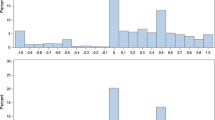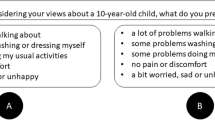Abstract
Background
Little is known about whether health-state preferences differ among Chinese populations. This study compared the preference values for EQ-5D-5L health states between mainland Chinese and Singaporean Chinese.
Methods
The preference values for ten EQ-5D-5L health states were elicited from general population samples of mainland Chinese and Singaporeans. In computer-assisted self-interviews, each participant completed five time trade-off (TTO) tasks to value five different EQ-5D-5L health states. The difference in TTO values between mainland Chinese and Singaporean Chinese was examined using random-effects linear regression and logistic regression models.
Results
A total of 194 eligible mainland Chinese and 145 eligible Singaporean Chinese provided data for this study. All ten health states considered, the mean TTO value was 0.18 for Singaporean Chinese and 0.35 for mainland Chinese, with the unadjusted and adjusted difference [95 % confidence interval (CI)] being −0.17 (−0.28, −0.07) and −0.16 (−0.27, −0.05). Singaporean Chinese had substantially lower TTO values than mainland Chinese for states with severe or extreme problems, with the adjusted difference being −0.30 (95 % CI −0.42, −0.17). On the other hand, Singaporean Chinese and mainland Chinese had similar TTO values for states with mild or moderate problems, with the adjusted (95 % CI) difference being 0.04 (−0.07, 0.15). Logistic regression analysis showed that Singaporean Chinese were more likely to rate health states with severe or extreme problems as worse than death compared to mainland Chinese.
Conclusions
Mainland Chinese and Singaporean Chinese have different preferences for EQ-5D-5L health states, supporting the development of local value sets for the EQ-5D-5L instrument for the two populations.
Similar content being viewed by others
References
Bloom, B.S.: Use of formal benefit/cost evaluations in health system decision making. Am. J. Manag Care 10(5), 329–335 (2004)
Gold, M.R., Siegel, J.E., Russell, L.B., Weinstein, M.C.: Cost-effectiveness in health and medicine. Oxford University Press, Oxford (1996)
Dolan, P.: Whose preferences count? Med. Decis. Making 19, 482–486 (1999)
Drummond, M.F., Sculpher, M.J., Torrance, G.W., O’Brien, B.J., Stoddart, G.L.: Methods for the economic evaluation of health care programmes, 3rd edn. Oxford University Press, New York (2005)
Dolan, P.: Modeling valuations for EuroQol health states. Med. Care 35(11), 1095–1108 (1997)
Feeny, D.H., Furlong, W.J., Torrance, G.W., Goldsmith, C.H., Zhu, Z., DePauw, S., Denton, M.: Multi-attribute and single attribute utility functions for the Health Utilities Index Mark 3 system. Med. Care 40(2), 113–128 (2002)
Brazier, J.E., Roberts, J., Deverill, M.D.: The estimation of a preference-based measure of health from the SF-36. J. Health Econ. 21(2), 271–292 (2002)
Torrance, G.W.: Measurement of health state utilities for economic appraisal. J. Health Econ. 5(1), 1–30 (1986)
Torrance, G.W., Thomas, W.H., Sackett, D.L.: A utility maximization model for evaluation of health care programs. Health Serv. Res. 7(2), 118–133 (1972)
Wisloff, T., Hagen, G., Hamidi, V., Movik, E., Klemp, M., Olsen, J.A.: Estimating QALY gains in applied studies: a review of cost-utility analyses published in 2010. Pharmacoeconomics 32(4), 367–375 (2014)
Baida, X., Roset, M., Herdman, M., Kind, P.: A comparison of United Kingdom and Spanish general population time trade-off values for EQ-5D health states. Med. Decis. Making 21(1), 7–16 (2001)
Luo, N., Johnson, J.A., Shaw, J.W., Coons, S.J.: A comparison of EQ-5D index scores derived from the US and UK population-based scoring functions. Med. Decis. Making 27(3), 321–326 (2007)
Wang, Q., Furlong, W., Feeny, D., Torrance, G.W., Barr, R.: How robust is the Health Utilities Index Mark 2 utility function? Med. Decis. Making 22(4), 350–358 (2002)
Norman, R., Cronin, P., Viney, R., King, M., Street, D., Ratcliffe, J.: International comparisons in valuing EQ-5D health states: a review and analysis. Value Health 12(8), 1194–1200 (2009)
Tsuchiya, A., Ikeda, S., Ikegami, N., Nishimura, S., Sakai, I., Fukuda, T., Hamashima, C., Hisashige, A., Tamura, M.: Estimating an EQ-5D population value set: the case of Japan. Health Econ. 11(4), 341–353 (2002)
Johnson, J.A., Luo, N., Shaw, J.W., Kind, P., Coons, S.J.: Valuations of EQ-5D health states: are the United States and United Kingdom different? Med. Care 43(3), 221–228 (2005)
Dolan, P., Gudex, C., Kind, P., Williams, A.: Valuing health states: a comparison of methods. J. Health Econ. 15(2), 209–231 (1996)
Department of Statistic Singapore. http://www.singstat.gov.sg/publications/publications_and_papers/reference/sif2013.pdf. Accessed 15 July 2013
Oppe, M., Devlin, N.J., van Hout, B., Krabbe, P.F.M., de Charro, F.: A program of methodological research to arrive at the new international EQ-5D-5L valuation protocol. Value Health 17(4), 445–453 (2014)
EuroQol Group. EQ-5D-5L user guide. Basic information on how to use the EQ-5D-5L instrument. http://www.euroqol.org/fileadmin/user_upload/Documenten/PDF/Folders_Flyers/UserGuide_EQ-5D-5L.pdf. Accessed 10 July 2013
Luo, N., Li, M., Stolk, E.A., Devlin, N.J.: The effects of lead time and visual aids in TTO valuations: a study of the EQ-VT framework. Eur. J. Health Econ. 14, S15–S24 (2013)
BMJ Group Blogs. BMJ supportive and palliative care. http://blogs.bmj.com/spcare/2012/04/17/one-can-die-but-cannot-fall-ill-a-survey-on-how-costs-may-affect-choice-of-therapy-in-singapore/. Accessed 15 May 2013
World Health Organization. World Health Report 2010. Health insurance systems in China: a briefing note. http://www.who.int/healthsystems/topics/financing/healthreport/37ChinaB_YFINAL.pdf (2010). Accessed 27 July 2013. Accessed 27 July 2013
Augestad, L.A., Rand-Hendriksen, K., Stavem, K., Kristiansen, I.S.: Time trade-off and attitudes toward euthanasia: implications of using ‘death’ as an anchor in health state valuation. Qual. Life Res. 22(4), 705–714 (2013)
Singapore Department of Statistics. Census of population 2010: statistical release 1 on demographic characteristics, education, language and religion. http://www.singstat.gov.sg/news/news/press12012011.pdf (2010). Accessed 27 July 2013
BBC News. Survey finds 300 m China believers. http://news.bbc.co.uk/2/hi/asia-pacific/6337627.stm. Accessed 27 July 2013
Wee, H.L., Li, S.C., Xie, F., Zhang, X.H., Luo, N., Cheung, Y.B., Machin, D., Fong, K.Y., Thumboo, J.: Are Asians comfortable with discussing death in health valuation studies? A study in multi-ethnic Singapore. Health Qual Life Outcomes. 4, 93 (2006)
Johnson, J.A., Ohinmaa, A., Murti, B., Sintonen, H., Coons, S.J.: Comparison of Finnish and U.S.-based visual analog scale valuations of the EQ-5D measure. Med. Decis. Making 20(3), 281–289 (2000)
Attema, A.E., Edelaar-Peeters, Y., Versteegh, M.M., Stolk, E.A.: Time trade-off: one methodology, different methods. Eur J Health Econ. 14(Suppl 1), S53–S64 (2013). doi:10.1007/s10198-013-0508-x
Luo, N., Wang, P., Thumboo, J., Lim, Y.W., Vrijhoef, H.J.: Valuation of EQ-5D-3L health states in Singapore: modeling of time trade-off values for 80 empirically observed health states. Pharmacoeconomics 30(5), 495–507 (2014)
Liu, G., Wu, H., Li, M., Gao, C., Luo, N.: Chinese time trade-off values for EQ-5D health states. Value Health (2014, in press)
Devlin, N.J., Buckingham, K., Shah, K., Tsuchiya, A., Tilling, C., Wilkinson, G., van Hout, B.: A comparison of alternative variants of the lead and lag time TTO. Health Econ. 22(5), 517–532 (2013)
Author information
Authors and Affiliations
Corresponding author
Rights and permissions
About this article
Cite this article
Wang, P., Li, M.H., Liu, G.G. et al. Do Chinese have similar health-state preferences? A comparison of mainland Chinese and Singaporean Chinese. Eur J Health Econ 16, 857–863 (2015). https://doi.org/10.1007/s10198-014-0635-z
Received:
Accepted:
Published:
Issue Date:
DOI: https://doi.org/10.1007/s10198-014-0635-z




